The global self-service billiards system market is valued at USD 134.6 million in 2025. It is slated to reach USD 234.3 million by 2035, recording an absolute increase of USD 99.7 million over the forecast period. This translates into a total growth of 74.1%, with the market forecast to expand at a compound annual growth rate (CAGR) of 5.7% between 2025 and 2035. The overall market size is expected to grow by nearly 1.74X during the same period, supported by increasing demand for automated entertainment solutions, growing adoption of smart technology in recreational facilities, and rising emphasis on operational efficiency and unmanned venue management across diverse commercial entertainment, community activity centers, and leisure facility applications.
Between 2025 and 2030, the self-service billiards system market is projected to expand from USD 134.6 million to USD 177.6 million, resulting in a value increase of USD 43.0 million, which represents 43.1% of the total forecast growth for the decade. This phase of development will be shaped by increasing urbanization and rising demand for automated entertainment services, growing adoption of IoT-enabled monitoring and payment systems in recreational facilities, and expanding deployment of unmanned billiards venues in high-traffic commercial areas and residential communities. Entertainment facility operators and community center managers are expanding their self-service billiards system capabilities to address the growing demand for cost-effective and technology-driven entertainment solutions that ensure operational efficiency and enhanced customer experience.
From 2030 to 2035, the market is forecast to grow from USD 177.6 million to USD 234.3 million, adding another USD 56.7 million, which constitutes 56.9% of the overall ten-year expansion. This period is expected to be characterized by the expansion of AI-powered management platforms and mobile payment integration, the development of cloud-based monitoring systems with advanced analytics capabilities, and the growth of specialized applications for smart city entertainment infrastructure and integrated leisure complexes. The growing adoption of digital transformation principles and automated service delivery models will drive demand for self-service billiards systems with enhanced connectivity and intelligent management features.
Between 2020 and 2025, the self-service billiards system market experienced steady growth, driven by increasing labor cost pressures in entertainment venues and growing recognition of automated systems as essential solutions for enhancing operational efficiency and customer convenience in diverse recreational and entertainment applications. The market developed as venue operators and facility managers recognized the potential for self-service billiards technology to reduce operational overhead, improve space utilization, and support contactless service delivery while meeting evolving consumer preferences for digital experiences. Technological advancement in sensor technologies and mobile payment platforms began emphasizing the critical importance of maintaining system reliability and user-friendly interfaces in diverse facility environments.
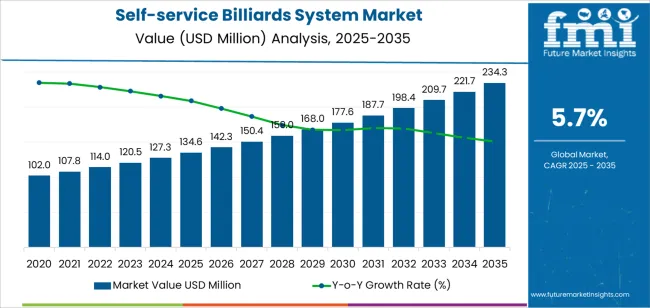
| Metric | Value |
|---|---|
| Estimated Value in (2025E) | USD 134.6 million |
| Forecast Value in (2035F) | USD 234.3 million |
| Forecast CAGR (2025 to 2035) | 5.7% |
Market expansion is being supported by the increasing global demand for automated entertainment solutions driven by labor cost escalation and operational efficiency requirements, alongside the corresponding need for smart facility management technologies that can enhance customer experience, enable unmanned operations, and maintain service quality across various commercial entertainment venues, community activity centers, and residential leisure facilities. Modern entertainment facility operators and venue managers are increasingly focused on implementing self-service billiards system solutions that can reduce staffing costs, improve revenue tracking, and provide seamless digital payment experiences in contemporary recreational environments.
The growing emphasis on contactless service delivery and digital transformation is driving demand for self-service billiards systems that can support unmanned venue operations, enable remote monitoring capabilities, and ensure comprehensive facility management performance. Entertainment venue operators' preference for automation technologies that combine operational efficiency with enhanced user experience and real-time analytics is creating opportunities for innovative self-service billiards implementations. The rising influence of smart city development and integrated leisure infrastructure is also contributing to increased adoption of self-service billiards systems that can provide superior convenience and operational intelligence without compromising service quality or customer satisfaction.
The market is segmented by component, application, and region. By component, the market is divided into software, hardware, and other system elements. Based on application, the market is categorized into commercial entertainment venues and community activity centers. Regionally, the market is divided into East Asia, Europe, North America, South Asia, Latin America, Middle East & Africa, and Eastern Europe.
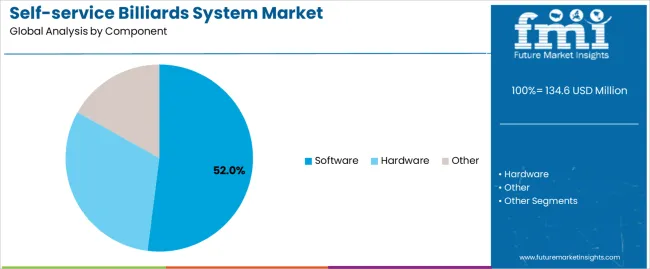
The software segment, which is expected to capture 52% of the self-service billiards system market in 2025, is projected to maintain its leading position, reaffirming its role as the preferred component category for automated management and digital payment processing applications. Entertainment venue operators and facility managers increasingly utilize software solutions for their comprehensive functionality, seamless payment integration capabilities, and proven effectiveness in enabling remote monitoring while maintaining operational efficiency. Software technology's proven effectiveness and application versatility directly address the industry requirements for intelligent venue management and automated service delivery across diverse entertainment platforms and facility categories.
This component segment forms the foundation of modern self-service billiards operations, as it represents the technology with the greatest contribution to operational automation and established performance record across multiple venue types and service models. Entertainment industry investments in digital transformation technologies continue to strengthen adoption among venue operators and facility managers. With market pressures requiring reduced operating costs and enhanced customer convenience, software-based management systems align with both operational objectives and service delivery requirements, making it the central component of comprehensive automated entertainment strategies.
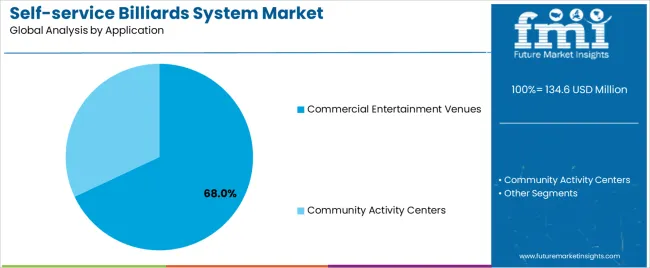
The commercial entertainment venues application segment is expected to represent the largest share of self-service billiards system demand in 2025, with a 68% market share. This segment underscores its critical role as the primary driver for system adoption across entertainment complexes, amusement centers, and dedicated billiards halls. Venue operators prefer self-service billiards systems for commercial deployment due to their exceptional labor cost reduction capabilities, revenue optimization benefits, and ability to support extended operating hours while ensuring operational efficiency and customer satisfaction. Positioned as essential technologies for modern entertainment venue management, self-service billiards systems offer both economic advantages and enhanced operational control.
The segment is supported by continuous innovation in automation technology and the growing availability of integrated platforms that enable superior venue management with enhanced analytics and improved customer engagement. Entertainment venue operators are investing in comprehensive automation programs to support increasingly competitive market conditions and consumer demand for convenient, technology-enabled entertainment experiences. As urbanization accelerates and entertainment preferences evolve, the commercial entertainment venues application will continue to dominate the market while supporting advanced automation utilization and operational optimization strategies.
The self-service billiards system market is advancing steadily due to increasing demand for automated entertainment solutions driven by rising labor costs and growing adoption of unmanned venue models that require specialized technology platforms providing enhanced operational efficiency and customer convenience across diverse entertainment venue, community facility, and leisure center applications. The market faces challenges, including high initial investment requirements for system deployment, technical complexity requiring ongoing maintenance and support, and competition from traditional staffed operations in established entertainment markets. Innovation in AI-powered management platforms and cloud-based monitoring solutions continues to influence product development and market expansion patterns.
The growing adoption of unmanned entertainment venue concepts is driving demand for comprehensive self-service billiards solutions that address unique operational requirements including remote monitoring capabilities, automated payment processing, facility security integration, and real-time performance analytics. Unmanned venues require advanced system platforms that deliver superior functionality across multiple operational parameters while maintaining reliability and cost-effectiveness. Entertainment entrepreneurs and facility investors are increasingly recognizing the competitive advantages of self-service billiards integration for unmanned venue development and market differentiation, creating opportunities for innovative system configurations specifically designed for next-generation automated entertainment applications.
Modern self-service billiards system providers are incorporating artificial intelligence algorithms and Internet of Things connectivity to enhance operational intelligence, enable predictive maintenance capabilities, and support comprehensive facility optimization through advanced data analytics and automated decision-making processes. Leading companies are developing AI-powered occupancy prediction systems, implementing IoT sensor networks for equipment monitoring, and advancing cloud platforms that enable centralized multi-venue management with real-time performance visibility. These technologies improve operational efficiency while enabling new business opportunities, including dynamic pricing strategies, targeted customer engagement programs, and data-driven facility optimization. Advanced technology integration also allows operators to support comprehensive business intelligence objectives and competitive differentiation beyond traditional service attributes.
The expansion of mobile payment adoption, smartphone-based service access, and digital wallet integration is driving demand for mobile-first self-service billiards platforms with seamless app-based booking functionality and frictionless payment experiences. These advanced applications require user-friendly mobile interfaces with robust backend systems that exceed traditional cash-based payment methods, creating enhanced customer engagement opportunities with differentiated service propositions. System providers are investing in mobile application development capabilities and payment gateway integration to serve tech-savvy customers while supporting innovation in customer relationship management and loyalty program implementation.
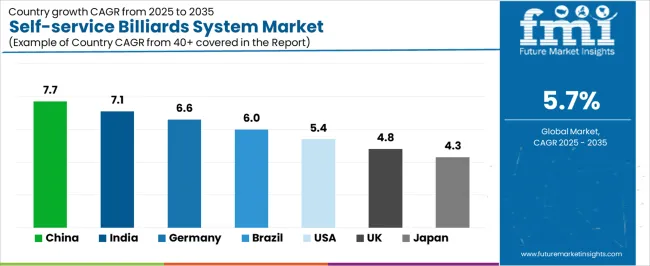
| Country | CAGR (2025-2035) |
|---|---|
| China | 7.7% |
| India | 7.1% |
| Germany | 6.6% |
| Brazil | 6.0% |
| United States | 5.4% |
| United Kingdom | 4.8% |
| Japan | 4.3% |
The self-service billiards system market is experiencing solid growth globally, with China leading at a 7.7% CAGR through 2035, driven by massive urbanization momentum, expanding unmanned entertainment venue adoption, and strong technology infrastructure supporting automated service delivery. India follows at 7.1%, supported by growing middle-class entertainment spending, increasing commercial real estate development, and rising adoption of smart facility management solutions. Germany shows growth at 6.6%, emphasizing leisure facility modernization, entertainment venue digitalization, and advanced automation technology integration. Brazil demonstrates 6.0% growth, supported by expanding urban entertainment infrastructure and growing demand for cost-effective venue operations. The United States records 5.4%, focusing on entertainment center automation, operational efficiency optimization, and technology-enabled customer experiences. The United Kingdom exhibits 4.8% growth, driven by leisure facility upgrades and digital payment adoption. Japan shows 4.3% growth, emphasizing technology integration in entertainment venues and automated service delivery systems.
The report covers an in-depth analysis of 40+ countries, with top-performing countries highlighted below.

Revenue from self-service billiards systems in China is projected to exhibit exceptional growth with a CAGR of 7.7% through 2035, driven by rapid urbanization creating demand for convenient entertainment options, expanding deployment of unmanned entertainment venues in residential communities, and comprehensive technology infrastructure supporting mobile payment and IoT integration capabilities. The country's massive urban population and increasing investment in smart facility technologies are creating substantial demand for self-service billiards solutions. Technology companies and entertainment venue operators are establishing extensive automated billiards facilities to serve both urban residential areas and commercial entertainment districts.
Demand for self-service billiards systems in India is expanding at a CAGR of 7.1%, supported by growing middle-class population with increasing entertainment spending capacity, expanding commercial real estate development incorporating recreational facilities, and rising adoption of smart building technologies in urban areas. The country's comprehensive urbanization programs and technology adoption are driving sophisticated self-service billiards capabilities throughout diverse entertainment sectors. Entertainment entrepreneurs and property developers are establishing automated billiards facilities to address growing demand for convenient recreational options.
Revenue from self-service billiards systems in Germany is growing at a CAGR of 6.6%, driven by the country's leisure facility modernization initiatives, entertainment venue digitalization programs, and precision engineering capabilities supporting advanced automation technology development. Germany's technology excellence and quality standards are driving sophisticated system capabilities throughout recreational sectors. Entertainment facility operators and technology providers are establishing comprehensive automation programs for next-generation entertainment venues.
Demand for self-service billiards systems in Brazil is anticipated to expand at a CAGR of 6.0%, supported by expanding urban entertainment infrastructure, growing demand for cost-effective recreational facility operations, and increasing adoption of digital payment technologies in commercial venues. Brazil's urbanization momentum and entertainment market development are driving demand for automated billiards solutions. Entertainment venue operators and real estate developers are investing in self-service systems to serve expanding urban markets.
Revenue from self-service billiards systems in the United States is projected to grow at a CAGR of 5.4%, supported by the country's emphasis on entertainment center operational efficiency, growing adoption of contactless service delivery, and increasing deployment of technology-enabled customer experiences in recreational facilities. The nation's comprehensive entertainment industry and technology infrastructure are driving demand for sophisticated self-service billiards solutions. Entertainment venue operators and facility managers are investing in automation technology to enhance operational performance.
Demand for self-service billiards systems in the United Kingdom is expected to expand at a CAGR of 4.8%, driven by leisure facility modernization programs, entertainment venue digital transformation initiatives, and growing adoption of automated service delivery in recreational sectors. The UK's entertainment industry evolution and technology adoption are supporting investment in self-service billiards technologies. Venue operators and facility managers are establishing automation capabilities for enhanced operational efficiency.

Revenue from self-service billiards systems in Japan is anticipated to grow at a CAGR of 4.3%, supported by the country's technology integration leadership in entertainment venues, precision automation systems, and strong emphasis on service quality with minimal staff intervention. Japan's technological sophistication and operational excellence are driving demand for advanced self-service billiards platforms. Entertainment facility operators and technology companies are investing in sophisticated automation capabilities.
How is the Self-service Billiards System Market Split by Country in Europe?
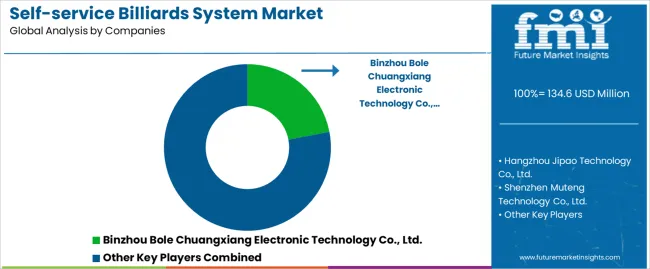
The self-service billiards system market in Europe is projected to grow from USD 28.7 million in 2025 to USD 49.8 million by 2035, registering a CAGR of 5.6% over the forecast period. Germany is expected to maintain leadership with a 27.3% market share in 2025, moderating to 26.8% by 2035, supported by leisure facility modernization, entertainment venue automation leadership, and strong technology integration capabilities.
France follows with 16.8% in 2025, projected at 17.1% by 2035, driven by urban entertainment development, leisure center upgrades, and digital transformation in recreational facilities. The United Kingdom holds 14.5% in 2025, expected to reach 14.9% by 2035 due to entertainment venue modernization and contactless service adoption. Italy commands 11.2% in 2025, rising slightly to 11.4% by 2035, while Spain accounts for 8.9% in 2025, reaching 9.1% by 2035 aided by tourism entertainment infrastructure and leisure facility development. Netherlands maintains 6.4% in 2025, up to 6.6% by 2035 due to smart facility integration and entertainment venue innovation. The Rest of Europe region, including Nordic countries, Eastern European markets, and other territories, is anticipated to hold 14.9% in 2025 and 14.1% by 2035, reflecting steady adoption in urban entertainment facilities and community recreational centers.

The self-service billiards system market is characterized by competition among specialized entertainment technology providers, automation system developers, and billiards equipment manufacturers. Companies are investing in software platform development, IoT integration capabilities, mobile application innovation, and hardware reliability enhancement to deliver comprehensive, user-friendly, and cost-effective self-service billiards solutions. Innovation in AI-powered management systems, cloud-based monitoring platforms, and mobile payment integration technologies is central to strengthening market position and competitive advantage.
Binzhou Bole Chuangxiang Electronic Technology Co., Ltd. provides comprehensive self-service billiards solutions with focus on unmanned venue operations, automated payment systems, and cloud-based management platforms serving Chinese entertainment markets. Hangzhou Jipao Technology Co., Ltd. offers innovative automation technologies with emphasis on mobile integration and intelligent facility management capabilities. Shenzhen Muteng Technology Co., Ltd. delivers advanced hardware and software solutions with focus on reliability and user experience optimization. Zongqiu Information Technology (Shanghai) Co., Ltd. specializes in integrated management platforms for multi-venue operations. Beijing Xiangdai Smart Technology Co., Ltd. provides IoT-enabled monitoring systems and automated control solutions. Beijing Tan Xiaoyu Sports Culture Co., Ltd. focuses on recreational facility automation and entertainment venue technologies.
24Billiards offers mobile-first booking and payment platforms for billiards facilities. Bilijardai JSC provides comprehensive venue management solutions for European markets. Olhausen Billiard Manufacturing, Inc. delivers integrated automation systems for premium billiards establishments. AE Schmidt Billiards specializes in commercial-grade self-service platforms. Craftmaster Billiards, Inc. focuses on automated payment and timing systems for billiards venues. Dynamic Billard Organization GmbH emphasizes technology integration for professional billiards facilities.
Self-service billiards systems represent a specialized entertainment automation segment within recreational facility management applications, projected to grow from USD 134.6 million in 2025 to USD 234.3 million by 2035 at a 5.7% CAGR. These technology-enabled automated platforms—primarily software, hardware, and integrated system configurations for unmanned billiards operations—serve as critical management solutions in commercial entertainment venues, community activity centers, and leisure facilities where operational efficiency, cost reduction, and enhanced customer convenience are essential. Market expansion is driven by increasing labor cost pressures, growing adoption of unmanned venue models, expanding mobile payment infrastructure, and rising demand for automated entertainment solutions across diverse entertainment and recreational facility segments.
How Industry Regulators Could Strengthen Service Standards and Operational Safety?
How Industry Associations Could Advance Technology Standards and Market Development?
How Self-service Billiards System Providers Could Drive Innovation and Market Leadership?
How Entertainment Venue Operators Could Optimize System Performance and Profitability?
How Technology Providers Could Enable Platform Innovation?
How Investors and Financial Enablers Could Support Market Growth and Innovation?
| Items | Values |
|---|---|
| Quantitative Units (2025) | USD 134.6 million |
| Component | Software, Hardware, Other |
| Application | Commercial Entertainment Venues, Community Activity Centers |
| Regions Covered | East Asia, Europe, North America, South Asia, Latin America, Middle East & Africa, Eastern Europe |
| Countries Covered | China, India, Germany, Brazil, United States, United Kingdom, Japan, and 40+ countries |
| Key Companies Profiled | Binzhou Bole Chuangxiang Electronic Technology Co., Ltd., Hangzhou Jipao Technology Co., Ltd., Shenzhen Muteng Technology Co., Ltd., Zongqiu Information Technology (Shanghai) Co., Ltd., Beijing Xiangdai Smart Technology Co., Ltd., Beijing Tan Xiaoyu Sports Culture Co., Ltd., 24Billiards, Bilijardai JSC, Olhausen Billiard Manufacturing, Inc., AE Schmidt Billiards, Craftmaster Billiards, Inc., Dynamic Billard Organization GmbH |
| Additional Attributes | Dollar sales by component and application category, regional demand trends, competitive landscape, technological advancements in automation systems, mobile payment integration, IoT connectivity innovation, and operational efficiency optimization |
The global self-service billiards system market is estimated to be valued at USD 134.6 million in 2025.
The market size for the self-service billiards system market is projected to reach USD 234.3 million by 2035.
The self-service billiards system market is expected to grow at a 5.7% CAGR between 2025 and 2035.
The key product types in self-service billiards system market are software, hardware and other.
In terms of application, commercial entertainment venues segment to command 68.0% share in the self-service billiards system market in 2025.






Full Research Suite comprises of:
Market outlook & trends analysis
Interviews & case studies
Strategic recommendations
Vendor profiles & capabilities analysis
5-year forecasts
8 regions and 60+ country-level data splits
Market segment data splits
12 months of continuous data updates
DELIVERED AS:
PDF EXCEL ONLINE
System-On-Package Market Size and Share Forecast Outlook 2025 to 2035
Systems Administration Management Tools Market Size and Share Forecast Outlook 2025 to 2035
Systemic Sclerosis Treatment Market - Trends & Forecast 2025 to 2035
System on Module Market Growth – Trends & Forecast 2025 to 2035
SLE Drugs Market Insights - Growth & Forecast 2025 to 2035
Systemic Mastocytosis Treatment Market
Systemic Infection Treatment Market
5G System Integration Market Insights - Demand & Growth Forecast 2025 to 2035
VRF Systems Market Growth - Trends & Forecast 2025 to 2035
Rail System Dryer Market Size and Share Forecast Outlook 2025 to 2035
HVAC System Analyzer Market Size and Share Forecast Outlook 2025 to 2035
DWDM System Market Analysis by Services, Product, Vertical, and Region – Growth, Trends, and Forecast from 2025 to 2035
Brake System Market Size and Share Forecast Outlook 2025 to 2035
Cloud Systems Management Software Market Size and Share Forecast Outlook 2025 to 2035
Hi-Fi Systems Market Size and Share Forecast Outlook 2025 to 2035
X-ray System Market Analysis - Size, Share, and Forecast 2025 to 2035
Power System Simulator Market Growth - Trends & Forecast 2025 to 2035
Cough systems Market
Atomic System Clocks Market Forecast and Outlook 2025 to 2035
Closed System Transfer Devices Market Insights – Industry Trends & Forecast 2024-2034

Thank you!
You will receive an email from our Business Development Manager. Please be sure to check your SPAM/JUNK folder too.
Chat With
MaRIA